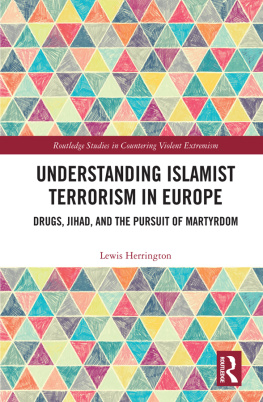

Published by
Imperial College Press
57 Shelton Street
Covent Garden
London WC2H 9HE
Distributed by
World Scientific Publishing Co. Pte. Ltd.
5 Toh Tuck Link, Singapore 596224
USA office: 27 Warren Street, Suite 401-402, Hackensack, NJ 07601
UK office: 57 Shelton Street, Covent Garden, London WC2H 9HE
Library of Congress Cataloging-in-Publication Data
Mullins, Sam (Professor of counterterrorism), author.
Home-grown jihad : understanding Islamist terrorism in the US and UK / Sam Mullins.
pages cm
Includes index.
ISBN 978-1-78326-803-0 (hc : alk. paper) -- ISBN 978-1-78326-486-5 (pbk : alk. paper)
1. Terrorism--United States--Prevention. 2. Terrorism--Great Britain--Prevention. 3. Terrorism--Religious aspects--Islam. 4. Terrorists--Recruiting--United States. 5. Terrorists--Recruiting--Great Britain. 6. Jihad. I. Title.
HV6432.M857 2015
363.3250941--dc23
2015030485
British Library Cataloguing-in-Publication Data
A catalogue record for this book is available from the British Library.
Copyright 2016 by Imperial College Press
All rights reserved. This book, or parts thereof, may not be reproduced in any form or by any means, electronic or mechanical, including photocopying, recording or any information storage and retrieval system now known or to be invented, without written permission from the Publisher.
For photocopying of material in this volume, please pay a copying fee through the Copyright Clearance Center, Inc., 222 Rosewood Drive, Danvers, MA 01923, USA. In this case permission to photocopy is not required from the publisher.
In-house Editors: Tasha DCruz/Dr. Sree Meenakshi Sajani
Typeset by Stallion Press
Email:
Printed in Singapore
There are things that we dont want to happen but we have to accept, things that we dont want to know but we have to learn
Hasna Shaheen Salam, mother of Abdul Moeed Abdul Salam, American al-Qaeda operative killed in Pakistan, December 2011.
Chris Brunmit and Gene Johnson, Why Did Boarding School Graduate Join al-Qaida? NBC News, January 18 2012, available at http://www.nbcnews.com/id/46037238/ns/us_news-life/t/why-did-boarding-school-graduate-join-al-qaida/, accessed January 18, 2012.
Acknowledgments
First and foremost I must thank my parents, without whose help and encouragement I would not be where I am today. I will also be forever grateful to my friend and mentor, Adam Dolnik, who taught me almost everything I know about terrorism, and to Nick Pratt, who taught me the rest. I wish to thank everyone at ICP for their support throughout the publication process, as well as the University of Wollongong (where this project started) and the George C. Marshall Center (where it has ended). Last, but certainly not least, a special thanks to my wife for her undying patience and support.
Introduction
A little more than a decade ago, relatively few people in the West had heard of Osama bin Laden or al-Qaeda, and when the attacks came on September 11, 2001 the world was truly shocked. Now, not only are we well aware that foreign terrorists adhering to distorted versions of Islam are intent on repeating such atrocities, but we have come to realize that the threat is also home-grown. Young men born and bred in Europe, North America, and Australia are radicalizing at home and pursuing violent jihad, either in conflicts overseas, or increasingly, in the countries where they grew up.
Large-scale successful attacks by home-grown terrorists such as in Madrid in 2004 and London in 2005 have been mercifully rare, thanks to the vigilance of our security services. Indeed, reports of disrupted terrorism plots have become such a steady and seemingly never-ending stream that we barely blink an eye at the latest raids or arrests. Nevertheless, smaller attacks carried out by autonomous groups and individuals inspired by the likes of al-Qaeda, but often lacking organizational support, continue to cause damage and distress (see ). Individuals like Nidal Malik Hasan (the Fort Hood shooter), Roshonara Choudhry (who stabbed a British Member of Parliament), and Arid Uka (who murdered two US servicemen at Frankfurt airport) have not managed to inflict the kind of devastation we have seen in the past. Yet they are stark reminders of the existence of an internal enemy, intent on taking up the banner of violent jihad against the West.
Indeed, bin Laden may be dead, but his cause lives on, as was demonstrated in dramatic fashion by the bombing of the Boston marathon in April 2013, and the brutal slaying of an off-duty British soldier on the streets of London the following month. As if this was not bad enough, we must also now contend with the so-called Islamic State (IS), which rose to prominence amidst the chaos of the conflicts in Syria and Iraq and for the time being appears to have eclipsed al-Qaeda as the preeminent jihadist organization. It too, has indicated its intent to strike against the West and is inspiring home-grown extremists to carry out attacks on its behalf.
Home-grown Islamist terrorism (HGIT) has become an undeniable part of life in the West, yet it is still something that is often poorly understood. Contrary to popular belief, this phenomenon did not suddenly spring up after 9/11, even though this was a key turning point in the global jihad. Indeed, the historical development of Islamist terrorism in different Western countries and the way in which this has helped shape the contemporary threat are often underappreciated. What is more, there are still confused notions about what motivates home-grown jihadis, and with some notable exceptions still relatively little in the way of systematic research that would give us a clear understanding of the range of HGIT activity in any given country.
Relying on open source material (mainly press reports and legal documents), this book is based upon more than seven years of painstaking research examining the development over time and the contemporary manifestation of Islamist terrorism in two of the most prominent countries in the Global War on Terror the US and the UK. By systematically collecting and analyzing data on all publicly identified cases of Islamist terrorism involving citizens or residents of these two countries, this book adds to and sometimes challenges existing research aimed at understanding who the terrorists are, how they operate, and how they are being dealt with by the security services.
Case-studies of individual countries are the first step in this process. Cross-comparison of results then adds another level of understanding. For example, it is widely believed that the home-grown threat in America has been significantly less than in Europe, yet there has been relatively little effort to measure this apparent difference. Moreover, popular explanations for this have tended to rely upon superficial description of Muslim populations, with little consideration for the historical development of militant infrastructure during the 1980s and 1990s, which laid the groundwork for developing jihadi subcultures. Similarly, explanations for the apparent rise in HGIT in the US in recent years pointed to continued American military operations overseas, with scant regard for the mechanisms of radicalization on the domestic stage. The detailed comparison of Islamist terrorist activity in the US and UK within this book is an attempt at illuminating the true nature of differences between these two countries, and provides in-depth, empirically supported, and theoretically relevant explanation. Ultimately, the more we understand the problem, the better equipped we will be to solve it.












